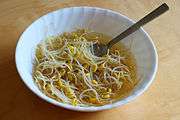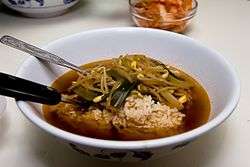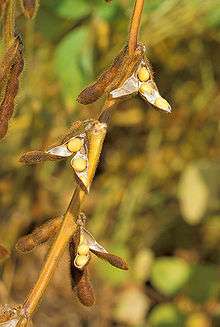Kongnamul
| Kongnamul | |
 Kongnamul | |
| Korean name | |
|---|---|
| Hangul | 콩나물 |
| Revised Romanization | kongnamul |
| McCune–Reischauer | k'ongnamul |
Kongnamul, an example of Korean cuisine, refers to a seasoned banchan (side dish) made from soybean sprouts, as well as being a term for the sprouts themselves in the Korean language. It is one of the most common banchan, as well as a basic ingredient of bibimbap.[1]
History
The exact origins of kongnamul is unknown, but it is assumed that it has been eaten since the Three Kingdoms of Korea period or early Goryeo era. Records of kongnamul can be found in the document from the Goryeo era, Hyangyak Gugeupbang (hangul: 향약구급방, hanja: 鄕藥救急方) where cultivation of the sprouts are mentioned; when Taejo of Goryeo was founding the country, the soldiers were saved from starving by growing bean sprouts in nearby streams.[2][3]
In the Joseon era document Sallim gyeongje (hangul: 산림경제, hanja: 山林經濟), cooking methods are mentioned,[3] and in another Joseon era document Seonghosaseol (hangul: 성호사설, hanja: 星湖僿說) it is said that the poor used kongnamul to make juk. Kongnamul is again mentioned in Cheongjanggwanjeonseo (hangul: 청장관전서, hanja: 靑莊館全書) as the main food consumed during famine.[2]
Preparation
After roots and the bean skin are removed, the sprouts are boiled. Drained sprouts are then seasoned with sesame oil, soy sauce, chopped green onions, sesame seeds, minced garlic, and a sprinkle of chili powder.[2]
Kongnamul dishes
Kongnamul is used in various dishes, from rice dishes to steamed seafood jjims. It is the main ingredients in the following:
- Kongnamulbap (콩나물밥): rice cooked together with sprouts, usually eaten with seasoned sauce made from sesame oil and soy sauce[4]
- Kongnamulguk (콩나물국): beansprout soup usually with dried anchovy stock. It is either spicy with red pepper flakes or mild and either hot or cold.[5]
- Kongnamulgukbap (콩나물국밥): rice in sprout soup, a specialty from the region of Jeonju[5]
- Mideodeokjjim (미더덕찜): steamed mideodeok, bracken, and kongnamul, with a spicy seasoning sauce[6]
- Agujjim (아구찜): steamed agwi fish with mideodeok and kongnamul
Gallery
 Kongnamul and other namul
Kongnamul and other namul Kongnamulguk
Kongnamulguk Kongnamulguk including red chili pepper powder
Kongnamulguk including red chili pepper powder Haemul jeongol (seafood hotpot) including kongnamul
Haemul jeongol (seafood hotpot) including kongnamul
See also
References
- ↑ (Korean) Kongnamul at Doosan Encyclopedia
- 1 2 3 (Korean) Kongnamul muchim at Doosan Encyclopedia
- 1 2 (Korean) Kongnamul at Encyclopedia of Korean Culture
- ↑ (Korean) Kongnamulbap at Doosan Encyclopedia
- 1 2 (Korean) Kongnamulguk at Encyclopedia of Korean Culture
- ↑ (Korean) Mideodeokjjim at Encyclopedia of Korean Culture
External links
| Wikimedia Commons has media related to Kongnamul. |
